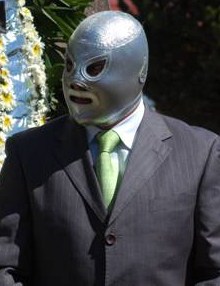Triplemanía III-B
| Triplemanía III-B | ||||
|---|---|---|---|---|

El Hijo del Santo, teamed with Octagón, Rey Misterio, Jr. and La Parka in the fifth match of the night
|
||||
| Information | ||||
| Promotion | Asistencia Asesoría y Administración | |||
| Date | June 18, 1995 (aired June 18, 1995 (PPPV) July 8, 1995 (Main event)) |
|||
| Attendance | 19,500 | |||
| Venue | Río Nilo Coliseum | |||
| City | Tonalá, Jalisco, Mexico | |||
| Triplemanía chronology | ||||
|
||||
Triplemanía III-B was the second part of the third Triplemanía wrestling show promoted by Asistencia Asesoría y Administración (AAA). 1995 was second year to feature the "Triplemanía Series" of shows with 3, referred to as III-A, III-B and III-C, where this was the second of the series. The show took place on June 18, 1995 in Tonala, Mexico. The Main event featured a Best two out of three falls Lucha de Apuestas "Mask vs. Mask" match where both Winners and Marabunta put their mask on the line.
In early 1992 Antonio Peña was working as a booker and storyline writer for Consejo Mundial de Lucha Libre (CMLL), Mexico's largest and the world's oldest wrestling promotion, and was frustrated by CMLL's very conservative approach to lucha libre. He joined forced with a number of younger, very talented wrestlers who felt like CMLL was not giving them recognition they deserved and decided to split from CMLL to create Asistencia Asesoría y Administración (AAA, or Triple A; Spanish for "Assistance, Consulting, and Administration"). After making a deal with the Televisa television network AAA held their first show in April, 1992. The following year Peña and AAA held their first Triplemanía event, building it into an annual event that would become AAA's Super Bowl event, similar to the WWE's WrestleMania being the biggest show of the year. The 1995 Triplemanía was the third year in a row AAA held a Triplemanía show and the sixth overall show under the Triplemanía banner.
The Triplemanía show featured seven professional wrestling matches with different wrestlers involved in pre-existing scripted feuds, plots and storylines. Wrestlers were portrayed as either heels (referred to as rudos in Mexico, those that portray the "bad guys") or faces (técnicos in Mexico, the "good guy" characters) as they followed a series of tension-building events, which culminated in a wrestling match or series of matches.
...
Wikipedia
